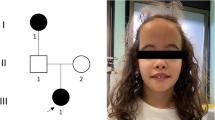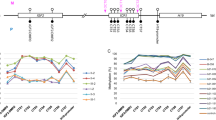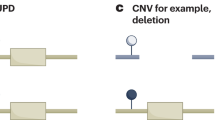Abstract
Genomic imprinting is an epigenetic modification that results in expression from only one of the two parental copies of a gene. Differences in methylation between the two parental chromosomes are often observed at or near imprinted genes. Beckwith–Wiedemann syndrome (BWS), which predisposes to cancer and excessive growth, results from a disruption of imprinted gene expression in chromosome band 11p15.5. One third of individuals with BWS lose maternal-specific methylation at KvDMR1, a putative imprinting control region within intron 10 of the KCNQ1 gene1,2,3, and it has been proposed that this epimutation results in aberrant imprinting and, consequently, BWS1,2. Here we show that paternal inheritance of a deletiion of KvDMR1 results in the de-repression in cis of six genes, including Cdkn1c, which encodes cyclin-dependent kinase inhibitor 1C. Furthermore, fetuses and adult mice that inherited the deletion from their fathers were 20–25% smaller than their wildtype littermates. By contrast, maternal inheritance of this deletion had no effect on imprinted gene expression or growth. Thus, the unmethylated paternal KvDMR1 allele regulates imprinted expression by silencing genes on the paternal chromosome. These findings support the hypothesis that loss of methylation in BWS patients activates the repressive function of KvDMR1 on the maternal chromosome, resulting in abnormal silencing of CDKN1C and the development of BWS.
NOTE: In the AOP version of this article, the fourth sentence of the abstract contained a mistake. The sentence should have read "Here we show that paternal inheritance of a deletion of KvDMR1 results in...". This has been corrected in the HTML and PDF versions, and the article will appear correctly in a forthcoming print issue.
This is a preview of subscription content, access via your institution
Access options
Subscribe to this journal
Receive 12 print issues and online access
$209.00 per year
only $17.42 per issue
Buy this article
- Purchase on Springer Link
- Instant access to full article PDF
Prices may be subject to local taxes which are calculated during checkout





Similar content being viewed by others
Change history
03 October 2002
This was incorrect in AOP version. Corrected the fourth sentence as per note.
References
Lee, M.P. et al. Loss of imprinting of a paternally expressed transcript, with antisense orientation to KVLQT1, occurs frequently in Beckwith–Wiedemann syndrome and is independent of insulin-like growth factor II imprinting. Proc. Natl Acad. Sci. USA 96, 5203–5208 (1999).
Smilinich, N.J. et al. A maternally methylated CpG island in KvLQT1 is associated with an antisense paternal transcript and loss of imprinting in Beckwith–Wiedemann syndrome. Proc. Natl Acad. Sci. USA 96, 8064–8069 (1999).
Engel, J.R. et al. Epigenotype-phenotype correlations in Beckwith–Wiedemann syndrome. J. Med. Genet. 37, 921–926 (2000).
Maher, E.R. & Reik, W. Beckwith–Wiedemann syndrome: imprinting in clusters revisited. J. Clin. Invest. 105, 247–252 (2000).
Leighton, P.A., Ingram, R.S., Eggenschwiler, J., Efstratiadis, A. & Tilghman, S.M. Disruption of imprinting caused by deletion of the H19 gene region in mice. Nature 375, 34–39 (1995).
Zhang, P. et al. Altered cell differentiation and proliferation in mice lacking p57KIP2 indicates a role in Beckwith–Wiedemann syndrome. Nature 387, 151–158 (1997).
Caspary, T. et al. Oppositely imprinted genes p57 (Kip2) and Igf2 interact in a mouse model for Beckwith–Wiedemann syndrome. Genes Dev. 13, 3115–3124 (1999).
Reik, W. & Murrell, A. Genomic imprinting. Silence across the border. Nature 405, 408–409 (2000).
Caspary, T., Cleary, M.A., Baker, C.C., Guan, X.J. & Tilghman, S.M. Multiple mechanisms regulate imprinting of the mouse distal chromosome 7 gene cluster. Mol. Cell. Biol. 18, 3466–3474 (1998).
Cleary, M.A. et al. Disruption of an imprinted gene cluster by a targeted chromosomal translocation in mice. Nature Genet. 29, 78–82 (2001).
Engemann, S. et al. Sequence and functional comparison in the Beckwith–Wiedemann region: implications for a novel imprinting center and extended imprinting. Hum. Mol. Genet. 9, 2691–2706 (2000).
Qian, N. et al. The IPL gene on chromosome 11p15.5 is imprinted in humans and mice and is similar to TDAG51, implicated in Fas expression and apoptosis. Hum. Mol. Genet. 6, 2021–2029 (1997).
Singer-Sam, J. Quantitation of specific transcripts by RT–PCR SNuPE assay. PCR Methods Appl. 3, S48–S50 (1994).
Cooper, P.R. et al. Divergently transcribed overlapping genes expressed in liver and kidney and located in the 11p15.5 imprinted domain. Genomics 49, 38–51 (1998).
Hatada, I. & Mukai, T. Genomic imprinting of p57-KIP2, a cyclin-dependent kinase inhibitor, in mouse. Nature Genet. 11, 204–206 (1995).
Srivastava, M. et al. H19 and Igf2 monoallelic expression is regulated in two distinct ways by a shared cis-acting regulatory region upstream of H19. Genes Dev. 14, 1186–1195 (2000).
Thorvaldsen, J.L., Duran, K.L. & Bartolomei, M.S. Deletion of the H19 differentially methylated domain results in loss of imprinted expression of H19 and Igf2. Genes Dev. 12, 3693–3702 (1998).
Yang, T. et al. A mouse model for Prader–Willi syndrome imprinting-center mutations. Nature Genet. 19, 25–31 (1998).
Zwart, R., Sleutels, F., Wutz, A., Schinkel, A.H. & Barlow, D.P. Bidirectional action of the Igf2r imprint control element on upstream and downstream imprinted genes. Genes Dev. 15, 2361–2366 (2001).
Horike, S. et al. Targeted disruption of the human LIT1 locus defines a putative imprinting control element playing an essential role in Beckwith–Wiedemann syndrome. Hum. Mol. Genet. 9, 2075–2083 (2000).
Lee, M.P. et al. Two novel genes in the center of the 11p15 imprinted domain escape genomic imprinting. Hum. Mol. Genet. 8, 683–690 (1999).
Grandjean, V., Smith, J., Schofield, P.N. & Ferguson-Smith, A.C. Increased IGF-II protein affects p57kip2 expression in vivo and in vitro: implications for Beckwith–Wiedemann syndrome. Proc. Natl Acad. Sci. USA 97, 5279–5284 (2000).
Kanduri, C. et al. A differentially methylated imprinting control region within the Kcnq1 locus harbors a methylation-sensitive chromatin insulator. J. Biol. Chem. 277, 18106–18110 (2002).
Sleutels, F., Zwart, R. & Barlow, D.P. The non-coding Air RNA is required for silencing autosomal imprinted genes. Nature 415, 810–813 (2002).
Li, E., Bestor, T.H. & Jaenisch, R. Targeted mutation of the DNA methyltransferase gene results in embryonic lethality. Cell 69, 915–926 (1992).
Bourc'his, D., Xu, G.L., Lin, C.S., Bollman, B. & Bestor, T.H. Dnmt3L and the establishment of maternal genomic imprints. Science 294, 2536–2539 (2001).
Hata, K., Okano, M., Lei, H. & Li, E. Dnmt3L cooperates with the Dnmt3 family of de novo DNA methyltransferases to establish maternal imprints in mice. Development 129, 1983–1993 (2002).
Lewandoski, M., Wassarman, K.M. & Martin, G.R. Zp3-cre, a transgenic mouse line for the activation or inactivation of loxP-flanked target genes specifically in the female germ line. Curr. Biol. 7, 148–151 (1997).
Paulsen, M. et al. Sequence conservation and variability of imprinting in the Beckwith–Wiedemann syndrome gene cluster in human and mouse. Hum. Mol. Genet. 9, 1829–1841 (2000).
Acknowledgements
We thank the Department of Laboratory Animal Research, Gene Targeting and Transgenics and Biopolymer core facilities at Roswell Park Cancer Institute for help; A. Nagy for the loxP-flanked neomycin-resistance cassette; R. Elliott for PWK mice; and W. Reik for the SD7 mice. This work was supported by grants from the Roswell Park Alliance Foundation and US National Cancer Institute/National Institutes of Health to M.J.H.
Author information
Authors and Affiliations
Corresponding author
Ethics declarations
Competing interests
The authors declare no competing financial interests.
Rights and permissions
About this article
Cite this article
Fitzpatrick, G., Soloway, P. & Higgins, M. Regional loss of imprinting and growth deficiency in mice with a targeted deletion of KvDMR1. Nat Genet 32, 426–431 (2002). https://doi.org/10.1038/ng988
Received:
Accepted:
Published:
Issue Date:
DOI: https://doi.org/10.1038/ng988
This article is cited by
-
Drug-induced loss of imprinting revealed using bioluminescent reporters of Cdkn1c
Scientific Reports (2023)
-
Along the Bos taurus genome, uncover candidate imprinting control regions
BMC Genomics (2022)
-
DNA sequence and chromatin modifiers cooperate to confer epigenetic bistability at imprinting control regions
Nature Genetics (2022)
-
From genotype to phenotype: genetics of mammalian long non-coding RNAs in vivo
Nature Reviews Genetics (2022)
-
KCNQ1OT1 promotes genome-wide transposon repression by guiding RNA–DNA triplexes and HP1 binding
Nature Cell Biology (2022)



